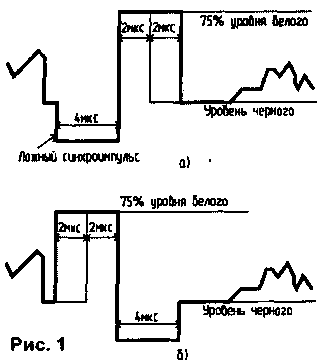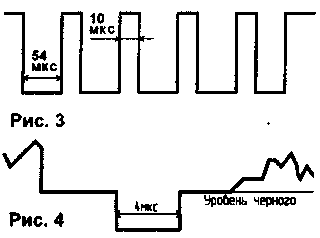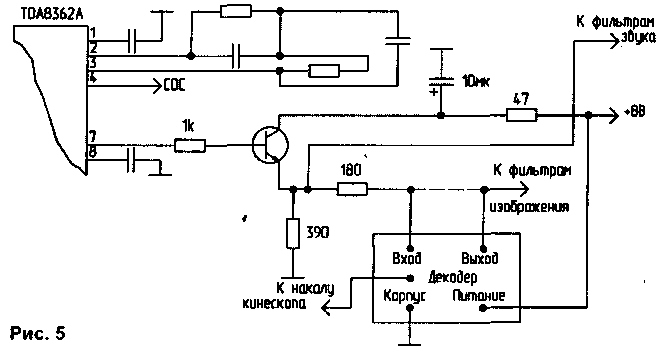
|
|
ENCYCLOPEDIA OF RADIO ELECTRONICS AND ELECTRICAL ENGINEERING Descrambler of scrambled TV channel. Encyclopedia of radio electronics and electrical engineering
Encyclopedia of radio electronics and electrical engineering / Телевидение For several years, coded broadcasting has been conducted in our city on Channel 29. To implement sufficiently reliable protection against unauthorized viewing of programs, a multivariant address coding system developed in Russia and used by many commercial television studios is used. Visually, the encoded program lacks horizontal and vertical synchronization. When viewing the full television signal using an oscilloscope, it was found that there are no vertical sync pulses in the encoded signal, and instead of horizontal pulses, synchronization pulses are transmitted, shown in Fig. 1. The number of lines during which the signals shown in Fig. 1 a and 16 are transmitted periodically changes, and this is one of the encoding options. The duration of the high-level pulses (75% of the white level) shown in Fig. 1 also changes. The subscriber's address and information about the coding method is transmitted within 1 µs at the end of each line. However, it is possible to make a descrambler capable of converting the encoded program into a standard full color television signal (PCTS) using any of the encoding methods embedded in the system on the transmitting side.
Such a descrambler can be made using the fact that the position of the transition point from low-level pulses (a level below black) to high-level pulses (Fig. 1) is constant in time and coincides with the beginning of horizontal sync pulses. Frame sync can be obtained by counting the number of transmitted lines. The circuit diagram of a descrambler that implements the described principle and provides automatic recognition of the coded program is shown in Fig.2. On the transistor VT3, a low-level pulse selector is assembled, which, after selection and inversion, charge the capacitor C6 and are fed to the input of the Schmitt trigger DD1.2. The time constant of the circuit R12, C6 is chosen to increase the duration of these pulses by 1...2 µs. After being inverted by the element DD1.3, these pulses come to one of the inputs of the element DD2.2. High-level pulses are emitted by the transistor VT2 and, after being inverted by the DD1.1 element, are fed to the second input of the DD2.2 element. Thus, in the presence of the encoded signal shown in Fig. 1, horizontal synchronization pulses are generated at the output of the DD2.2 element. With the help of elements VD4, R17, C9, their duration is brought to the standard (4,7 μs), and after being inverted by the DD1.4 element, they come to the base of the transistor VT8, which, opening, “cuts” them into the PCTS. Resistor R23 serves to adjust the level of these pulses. To ensure the suppression of false sync pulses (Fig. 1 a), elements VT4, VT5, DD2.1, DD1.5, VD5, R16 are used. After selection by the transistor VT3, all low-level pulses are fed to the emitter follower VT4, and then to one of the inputs of the DD2.1 element. The other input DD2.1 receives the signal generated by the element DD1.4 (inserted horizontal sync pulses). The chain VT5, R13, C7 serves to increase the duration of these pulses up to 70 ... 110 μs. Therefore, at the output of the element DD2.1 in the case of receiving the signal shown in Fig. 1 a, after passing through the first encoded line, pulses appear. These are pulses that exactly match in duration and location of the fronts to false sync pulses present in the encoded signal. The DD1.5 element inverts them, and through the VD5 diode with a series-connected resistor R16, which serves to adjust the degree of suppression of false sync pulses, the signal is fed to the base of the VT7 emitter follower. Frame synchronization is performed by counting the number of lines. To do this, it is convenient to use the filament voltage of the kinescope (CRT). In almost all modern TVs, the filament voltage to the kinescope is supplied from a horizontal scanning transformer and contains higher harmonic components that are necessary for the descrambler to work. On the transistor VT1 and the oscillatory circuit L1, C2, the second harmonic of the horizontal frequency is selected. After inverting on the DD3.1 element, the double horizontal scanning frequency comes to the counting input of the DD5 microcircuit. Elements DD3.2, DD3.3, DD3.4, DD4 are used to generate framing pulses that appear at the output of the element DD4.2, and reset the counter DD5. Button S1 is designed to adjust the phase of frame synchronization pulses. Thus, one of the inputs of the DD2.3 element receives frame rate pulses with a duration of 288 μs (4,5 lines). The other input of the element DD2.3 is connected to the capacitor C10, which, in the case of receiving a coded signal, is charged with horizontal synchronization pulses. When receiving conventional TV programs, the voltage at input 9 of the DD2.3 element corresponds to a logical zero, and the descrambler automatically stops working. When receiving encoded programs, after being inverted by the transistor VT6, frame synchronization pulses enter the input of the DD2.4 element, which, together with the elements VD8, R25, C11 and DD1.6, performs the function of their "cutting" (Fig. 3). "Cutting" vertical sync pulses is necessary to ensure horizontal synchronization during the passage of vertical sync pulses. After that, the vertical sync pulses, in the same way as the lowercase ones, "crash" into the PCTS.
The appearance of the decoded signal is shown in Fig.4. A voltage regulator is assembled on the VT9 transistor. Construction and details All resistors used in the descrambler are rated at 0,125 watts. The exception is R26, which should provide a power dissipation of the order of 0,5 watts. Permissible deviations in the values of the elements: C2, C6, SP, R12, R25 - ± 5%, the rest - ± 20%. The inductance L1 is wound on a toroidal magnetic circuit made of M200NN ferrite with overall dimensions of 20x12x4 mm and contains 110 turns of PEV 0,1 wire. There are no strict requirements for the quality factor of the L1 coil, so it can be wound on any other magnetic circuit. All transistors and diodes can have any letter index. Instead of DD1, you can use K533TL2: instead of DD2 - K133LAZ, K155LAZ, K533LAZ, K1533LAZ; instead of DD3 - K564LA7, K176LA7; instead of DD4 - K564LE10, K176LE10. Capacitors C12, C13 must be located in close proximity to the microcircuits DD1, DD2. Connecting to a TV The described descrambler can be connected to almost any TV (except for a tube TV), for this it is necessary to include it in the open circuit of a low-frequency video signal with a swing of 2 ... In Western-made TVs, as well as in 4,5USTST, the descrambler is switched on after the emitter follower, which is located between the video processor and the ceramic band-pass and notch filters. An example of a connection diagram for a TV with a TDA4A video processor is shown in Fig. 5. The dotted line in the figure shows the chain that needs to be broken. Adjustment Set the slider of the resistor R4 to the leftmost position according to the diagram. Turn on the TV to a coded program. Set using the resistor R17 the duration of the pulses at the output of the element DD2.4 equal to 4...4,7 µs. Connect the oscilloscope to the output of the descrambler and, by rotating the slider of the resistor R23, achieve equality in the amplitudes of the transmitted and time horizontal synchronization pulses. Then, using resistor R16, set the required amount of suppression of false sync pulses, while the signal present at the output of the descrambler must correspond to Fig.4. Lastly, by rotating the slider of the resistor R4, achieve the best quality for receiving the decoded program. The described descrambler was successfully installed in Philips, Samsung and Electron 51ТЦ4303 TVs. All televisions modified in this way received a coded channel with almost the same quality as non-coded ones. After equipping the TV with such a descrambler, it becomes possible to record encoded programs on a VCR. To do this, just connect the LF output of the TV to the IF input of the VCR and turn on the latter for recording. Literature
Author: V. Meshcheryakov, Tambov; Publication: N. Bolshakov, rf.atnn.ru
Alcohol content of warm beer
07.05.2024 Major risk factor for gambling addiction
07.05.2024 Traffic noise delays the growth of chicks
06.05.2024
▪ Oxytocin in the fight against autism
▪ section of the site Application of microcircuits. Article selection ▪ article Scandal in a noble family. Popular expression ▪ article How do Arabs write and read numbers? Detailed answer ▪ article Deputy Director for Human Resources. Job description ▪ article Electronic hourglass. Encyclopedia of radio electronics and electrical engineering ▪ article Your first transmitter. Encyclopedia of radio electronics and electrical engineering
Home page | Library | Articles | Website map | Site Reviews www.diagram.com.ua |






 Arabic
Arabic Bengali
Bengali Chinese
Chinese English
English French
French German
German Hebrew
Hebrew Hindi
Hindi Italian
Italian Japanese
Japanese Korean
Korean Malay
Malay Polish
Polish Portuguese
Portuguese Spanish
Spanish Turkish
Turkish Ukrainian
Ukrainian Vietnamese
Vietnamese




 Leave your comment on this article:
Leave your comment on this article: